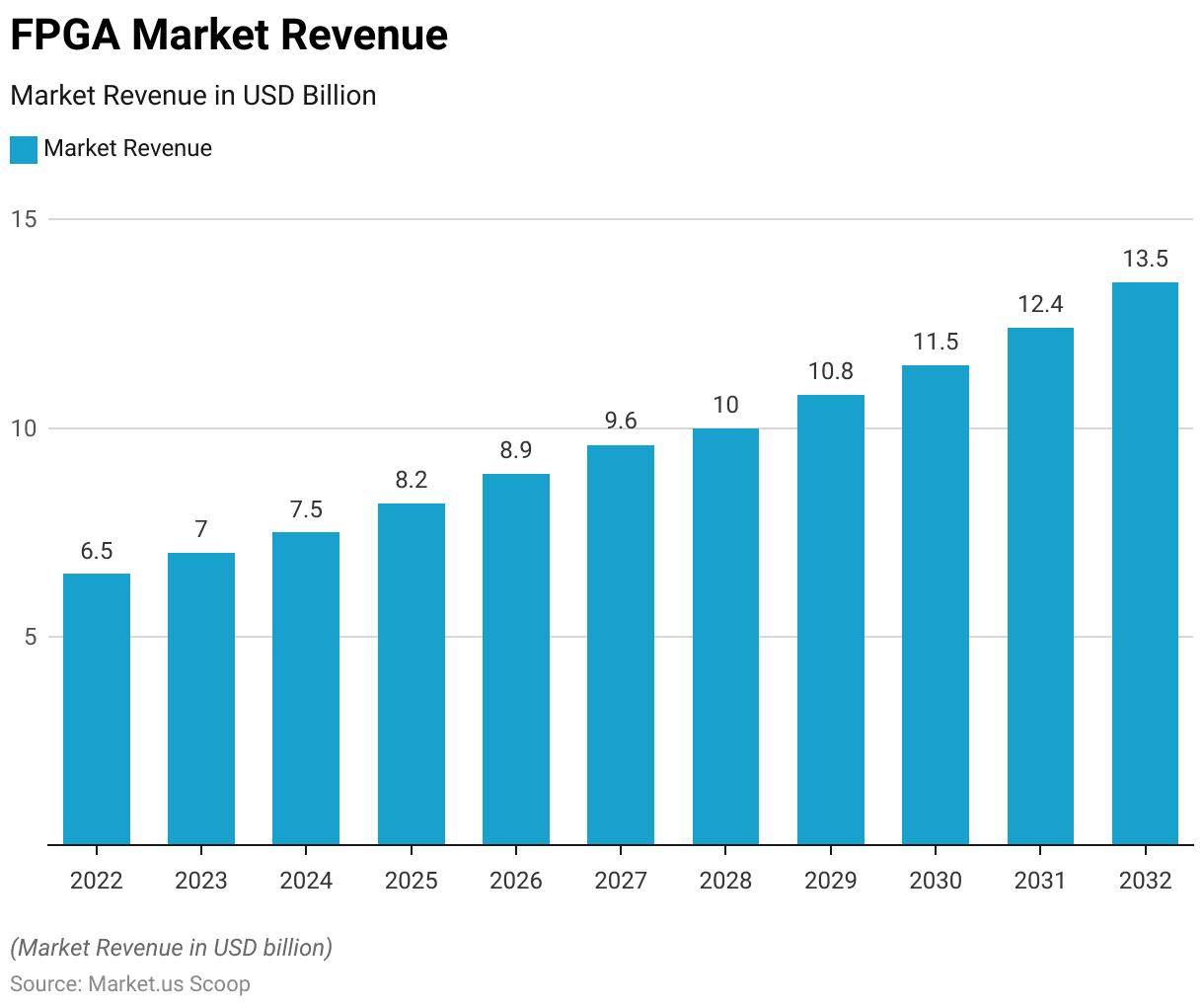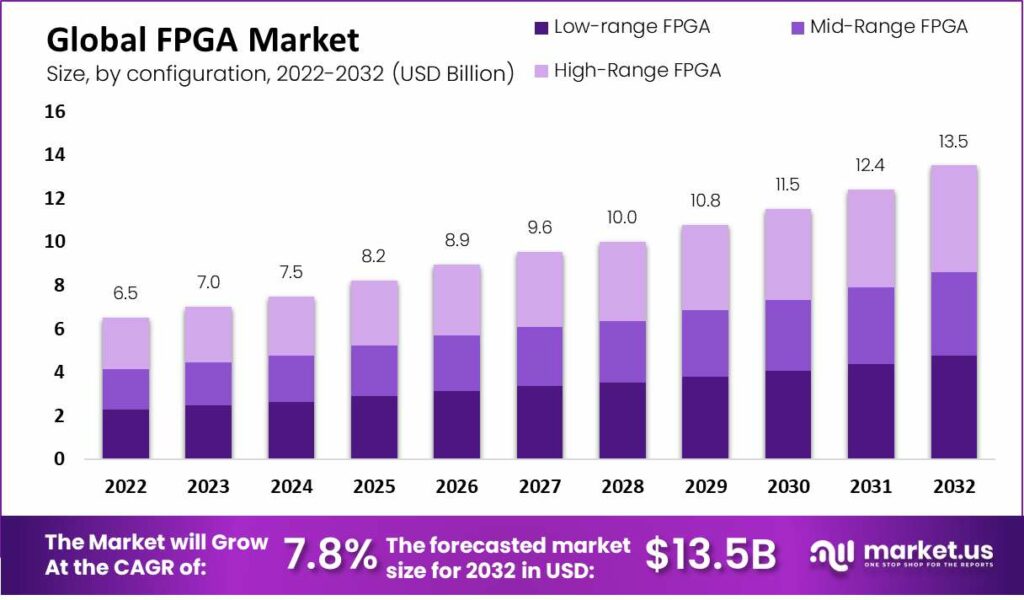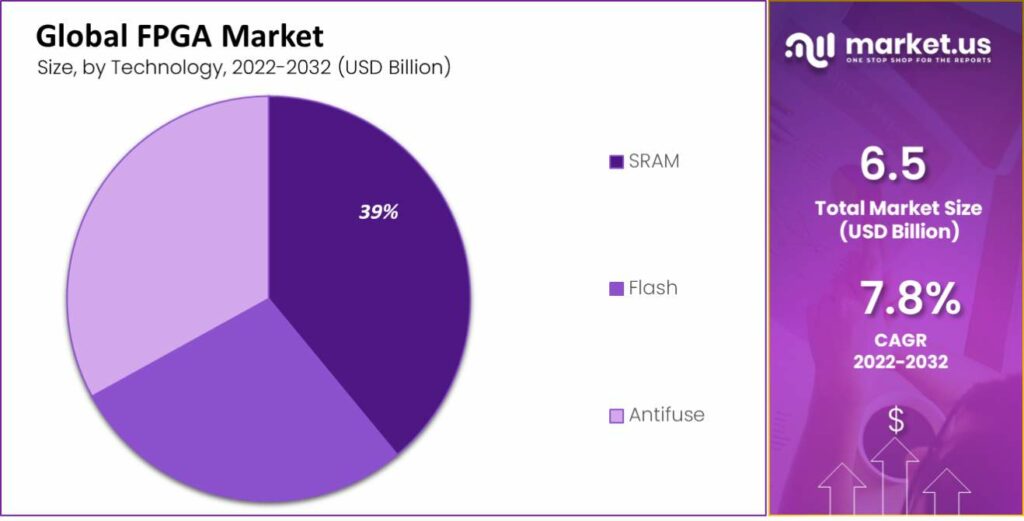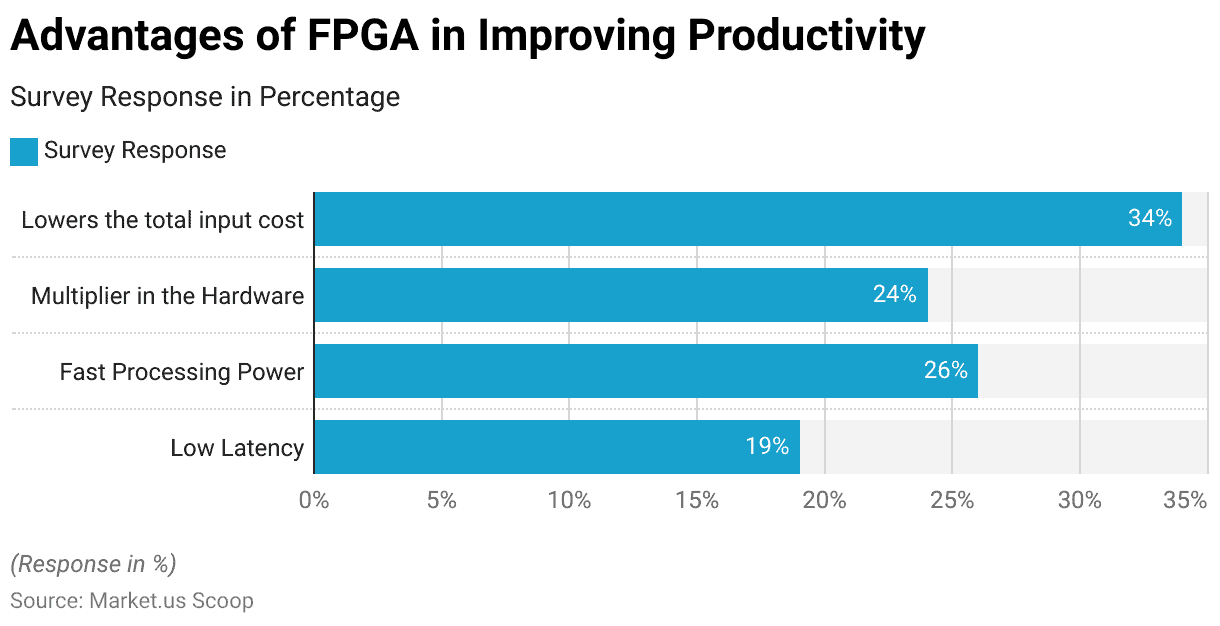Table of Contents
Introduction
According to FPGA Statistics, Field-Programmable Gate Arrays, or FPGAs, are semiconductors that provide adaptable and changeable hardware capabilities. They contain various changeable logic units and programmable connections, permitting individuals to craft and execute individualized digital circuits without creating their unique silicon.
FPGAs are utilized across a range of sectors, such as telecommunications, aerospace, and industrial automation, where there’s a need for swift creation, minimal delays, and potent computing. Their adaptability renders them a precious asset for hardware development, research, and distinctive computing responsibilities.
Editor’s Choice
- The Global Field-Programmable Gate Array (FPGA) market is poised for steady growth in the coming years at a CAGR of 7.8%.
- In 2022, the FPGA market revenue stood at USD 6.5 billion, expected to increase to USD 13.5 billion in 2032.
- In 2022, the total low-range FPGAs contributed USD 2.3 billion, mid-range FPGAs at USD 1.8 billion, and high-range FPGAs generating USD 2.4 billion.
- As of the latest data, SRAM-based FPGAs dominate the market with a 39% share.
- Resistance (R) on the switch and parasitic capacitance (C) play essential roles in signal propagation, with ONO anti-fuse FPGAs having moderate resistance (300-500 ohms) and low capacitance (5F), while amorphous anti-fuse FPGAs exhibit lower resistance (50-100 ohms) and slightly higher capacitance (1.1-1.3F).
- The Cyclone V consists of two primary elements: the FPGA segment and a hard processor system (HPS) centered around a single- or dual-core 32-bit Arm Cortex-A9 MPCORE clocked at 925 MHz.
- 34% of respondents appreciate FPGAs’ capability to lower the total input cost, making them a cost-effective solution in various applications.
FPGA Market Overview
Global FPGA Market Size
- The Global Field-Programmable Gate Array (FPGA) market is poised for steady growth in the coming years at a CAGR of 7.8%.
- In 2022, the FPGA market revenue stood at USD 6.5 billion, expected to increase to USD 7.0 billion in 2023.
- The trend of growth is set to persist, with revenues projected to reach USD 11.5 billion in 2030, USD 12.4 billion in 2031, and USD 13.5 billion in 2032.

Field Programming Gate Array Market Size – by Configuration
- The Global Field Programming Gate Array (FPGA) market is projected to experience steady growth over the next decade.
- In 2022, the total market revenue stood at USD 6.5 billion, with low-range FPGAs contributing USD 2.3 billion, mid-range FPGAs at USD 1.8 billion, and high-range FPGAs generating USD 2.4 billion.
- As we move into 2032, the market is expected to expand significantly, reaching a total revenue of USD 13.5 billion.
- This growth will be driven by the increasing demand for FPGAs across various industries.
- Low-range FPGAs are anticipated to reach USD 4.8 billion, mid-range FPGAs at USD 3.8 billion, and high-range FPGAs make up USD 4.9 billion of the total market revenue.

Global Field Programming Gate Array Market Share – by Technology
- Technology’s market share distribution reveals an intriguing landscape in the global Field Programming Gate Array (FPGA) market.
- As of the latest data, SRAM-based FPGAs dominate the market with a 39% share. These FPGAs, known for their reconfigurability and speed, are favored in applications where flexibility and quick turnaround times are crucial.
- Following closely behind are Flash-based FPGAs, capturing a substantial 28% market share. Flash FPGAs are valued for their non-volatile configuration storage, making them ideal for applications requiring data persistence and security.
- Lastly, Antifuse-based FPGAs hold a notable 33% market share. Antifuse technology is preferred when reliability and security are paramount, as it offers a one-time programmable configuration that cannot be altered once set.

Comparison Analysis of Different FPGA Programming Technologies
- When comparing different FPGA programming technologies, several key factors come into play.
- First, we consider volatility, with SRAM-based FPGAs allowing for volatile reprogramming in-circuit. In contrast, anti-fuse-based FPGAs, both ONO and amorphous types, offer non-volatile programming, making them suitable for applications where data persistence is critical.
- Next, regarding the area and electrical characteristics, SRAM-based FPGAs tend to have larger area footprints than the anti-fuse variants, which feature small fuse elements and programming transistors.
- Resistance (R) on the switch and parasitic capacitance (C) play essential roles in signal propagation, with ONO anti-fuse FPGAs having moderate resistance (300-500 ohms) and low capacitance (5F), while amorphous anti-fuse FPGAs exhibit lower resistance (50-100 ohms) and slightly higher capacitance (1.1-1.3F).
FPGA Architecture
- Fundamentally, an FPGA’s architecture consists of many vital elements called configurable logic blocks (CLBs). These CLBs are encircled by a system of adaptable connections, commonly called a fabric, which facilitates the routing of signals between these CLBs.
- Moreover, input/output (I/O) blocks connect the FPGA to external devices. Depending on the particular manufacturer, these CLBs might be denoted by alternate terms like logic blocks (LBs), logic elements (LEs), or logic cells (LCs).
- Within an individual CLB, you’ll find multiple logic blocks. An important component of an FPGA is the lookup table (LUT), which is a defining feature. LUTs store a predetermined set of logical results for every possible input combination.
- Typically, LUTs with four to six input bits are extensively employed. Standard logic functions like multiplexers (mux), full adders (FAs), and flip-flops are frequently encountered within this context.
SoC FPGAs
- SoC FPGAs, short for System-on-Chip Field-Programmable Gate Arrays, offer various processing capabilities tailored to diverse applications.
- Take, for example, Intel’s Cyclone V, a cost-effective and energy-efficient SoC FPGA.
- It’s designed to excel in high-volume scenarios, such as controlling industrial motors, bridging protocols, handling video processing tasks, and powering portable devices.
- The Cyclone V consists of two primary elements: the FPGA segment and a hard processor system (HPS) centered around a single- or dual-core 32-bit Arm Cortex-A9 MPCORE clocked at 925 MHz.
Key FPGA Components
Configurable Logic Blocks
- The core element of a field programmable gate array (FPGA) is the Configurable Logic Block (CLB). This is a logic cell that can be configured to perform specific functions.
- These CLBs are connected through a connection block, which includes essential components like carry and control logic, transistor pairs, and lookup tables (LUTs) to handle the required logical operations in a design.
- To create a CLB, you can use logic-based multiplexers or LUTs. In LUT-based logic, a CLB consists of a D flip-flop, a lookup table, and a 2:1 multiplexer.
Interconnects
- In FPGAs, this region handles the distinctive connections among logic cells in various blocks. Switch boxes containing multiple semiconductor switches are commonly used for this purpose.
- These electrically programmable links serve as the routes for transmitting signals between logic blocks.
- The routes consist of wire segments of different lengths, interconnected by electrically programmable switches.
- The number of components allotted for these pathways influences the FPGA’s density.
Routing
- Programmable routing is critical, often occupying more than half of the fabric surface and affecting application latency.
- It comprises pre-made wire segments and pre-set switches.
- Configuring the right switch combination, any output from a function block can be connected to any input. There are two fundamental routing architectures in field-programmable gate arrays (FPGAs).
- Designs follow a hierarchy, with higher-level components incorporating lower-level modules and connecting signals. This approach drives the need for hierarchical FPGAs.
I/O Blocks
- Interfacing pins are vital for connecting logic blocks to external components in an FPGA. This connection point between the FPGA and external circuits is called the Input Output Block (IOB).
- IOBs are programmable input and output devices tailored to handle the diverse requirements of input/output signals with varying electrical characteristics.
- These IO blocks are the crucial link bridging the routing architecture and configurable logic blocks (CLBs) with external elements.
- These IO blocks establish one-way or two-way programmable links, connecting the package pins to the device’s internal circuitry.
- Unlike earlier FPGAs without built-in processors, modern FPGAs offer versatility for various applications.
On-chip Memory
- Initially, FFS (Flip-Flops) integrated within the FPGA’s logic blocks served as the initial form of on-chip memory.
- However, as the logic capacity of field-programmable gate arrays (FPGAs) improved, they began to be used in larger systems, which consistently required on-chip memory to store and reuse data efficiently.
- Building extensive RAMs from registers and LUTs proved significantly less space-efficient, about 100 times less dense than an SRAM block. As a result, the need for denser on-chip storage became evident.

Advantages of FPGAs
- As survey responses indicate, FPGAs offer several advantages that significantly enhance productivity.
- A notable advantage is their ability to provide low latency, cited by 19% of respondents. This means that FPGAs can rapidly process data, reducing delays in various applications.
- Another key benefit highlighted by 26% of respondents is their fast processing power, enabling swift execution of complex tasks.
- FPGAs also excel in handling multiplication operations directly in hardware, a feature valued by 24% of those surveyed.
- Additionally, 34% of respondents appreciate FPGAs’ capability to lower the total input cost, making them a cost-effective solution in various applications.
FPGA Cost
- Brand-new FPGAs typically come with a price tag exceeding $10,000, whereas new GPUs are generally priced at several hundred to several thousand dollars.
- It’s worth noting that FPGA prices tend to decrease over time, and smaller and more affordable FPGA options are available.
- However, if a designer aims to utilize the latest and largest FPGA, they should anticipate a cost of at least $10,000 for the FPGA device alone.
Discuss your needs with our analyst
Please share your requirements with more details so our analyst can check if they can solve your problem(s)



